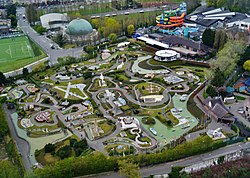  Mini-Europe viewed from the Atomium | |
| Location | Avenue du Football / Voetballaan 1, 1020 Laeken, City of Brussels, Brussels-Capital Region, Belgium |
|---|---|
| Coordinates | 50°53′38″N4°20′20″E / 50.894°N 4.339°E |
| Status | Operating |
| Opened | 1989 |
| Operating season | March–October |
| Website | Official website |
Mini-Europe is a miniature park located in the Bruparck entertainment park, at the foot of the Atomium, in Brussels, Belgium. Mini-Europe has reproductions of monuments in the European Union and other countries within the continent of Europe on display, at a scale of 1:25. Roughly 80 cities and 350 buildings are represented. [1] Mini-Europe receives 350,000 visitors per year [2] and has a turnover of €4 million. [3]
Contents
- History
- Inception, opening and growth
- Neo Project and potential closure
- Exhibits
- Building the monuments
- Animations
- Gardens
- Spirit of Europe
- List of models
- Austria
- Belgium
- Bulgaria
- Croatia
- Cyprus
- Czech Republic
- Denmark
- Estonia
- Finland
- France
- Germany
- Greece
- Hungary
- Ireland
- Italy
- Latvia
- Lithuania
- Luxembourg
- Malta
- Netherlands
- Poland
- Portugal
- Romania
- Slovakia
- Slovenia
- Spain
- Sweden
- Ukraine
- United Kingdom
- Other
- See also
- External links
- References
- Footnotes
- Citations
Mini-Europe is the brainchild of Johannes A. Lorijn, who founded similar miniature parks in Austria and Spain. [4] The park contains live action models such as trains, mills, an erupting Mount Vesuvius, and cable cars. A guide gives the details on all the monuments. At the end of the visit, the Spirit of Europe exhibition gives an interactive overview of the EU in the form of multimedia games. [5]
The park is built on an area of 24,000 m2 (300,000 sq ft). The initial investment was of 50 million Belgian francs in 1989, [6] [a] on its inauguration by then-Prince Philippe of Belgium. [7]


























